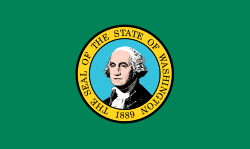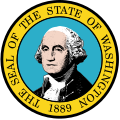
The U.S. state of Washington has 21 official emblems, as designated by the Washington State Legislature. These symbols, which reflect the history and culture of the state, are often opportunities for politicians to "tie themselves to popular symbols", for teachers to highlight the legislative process to their students, and for lobbyists to "have their products given official designation". [1]
Contents
- Insignia
- Species
- Geology
- Culture
- Unofficial symbols and unsuccessful proposals
- See also
- References
- External links
While some of the symbols are unique to Washington, others are used by multiple states. For example, the willow goldfinch (also known as the American goldfinch), Washington's state bird, is also an official symbol for Iowa and New Jersey. [2] Washington's state grass, bluebunch wheatgrass, is also a symbol for the state of Montana. [3] The square dance and apple are commonly used state dances and state foods, respectively. While most states have an official motto and nickname, Washington's motto ("Al-ki", meaning "by and by" in Chinook Jargon) and nickname ("The Evergreen State") have never been officially adopted by the Legislature. [4]
Washington's first official symbol was its flag, adopted in 1923. While some symbols, including the state flower and state seal, were selected before then, they were not adopted by the Legislature until later. Washington's second symbol was the western hemlock, selected as the state tree in 1947. Fourteen symbols were added between 1950 and 2000. Five symbols have been adopted in the 21st century. The newest symbol of Washington is state dinosaur, "Suciasaurus rex", which was declared in 2023.






















